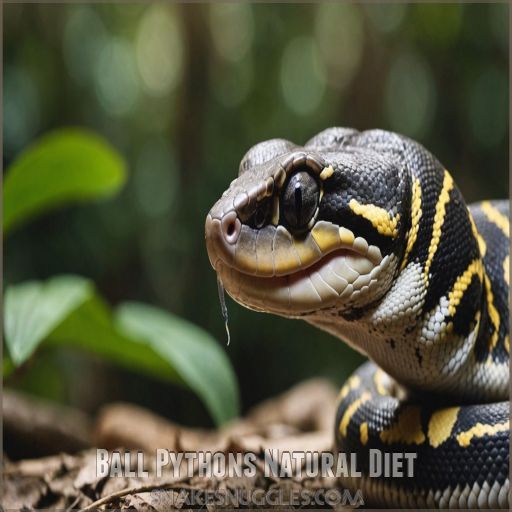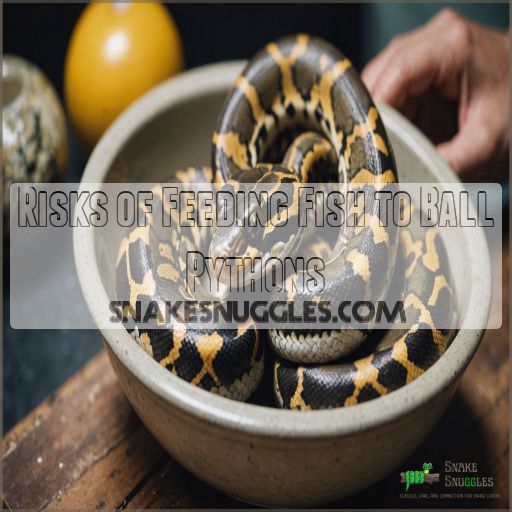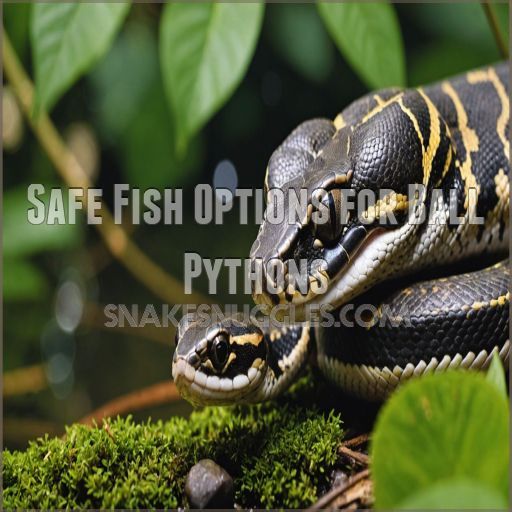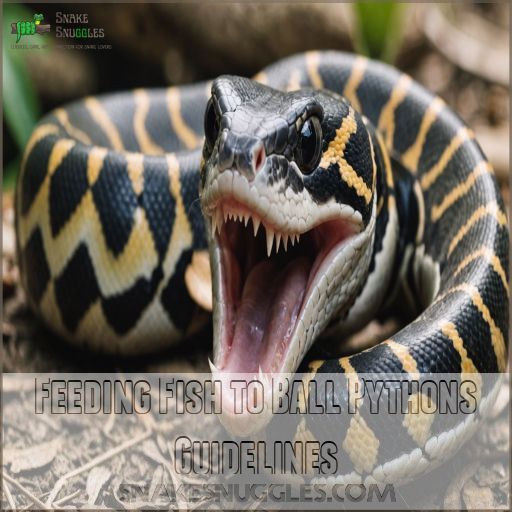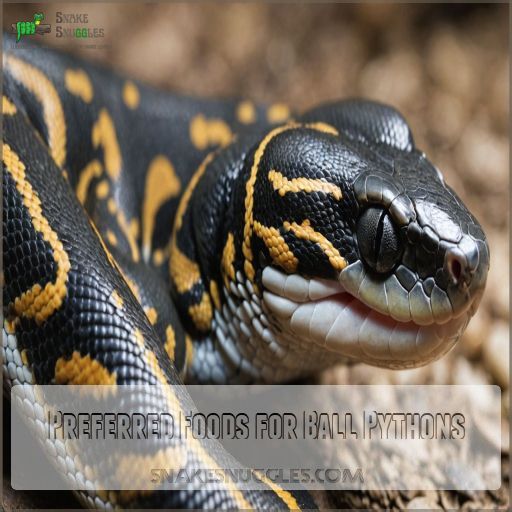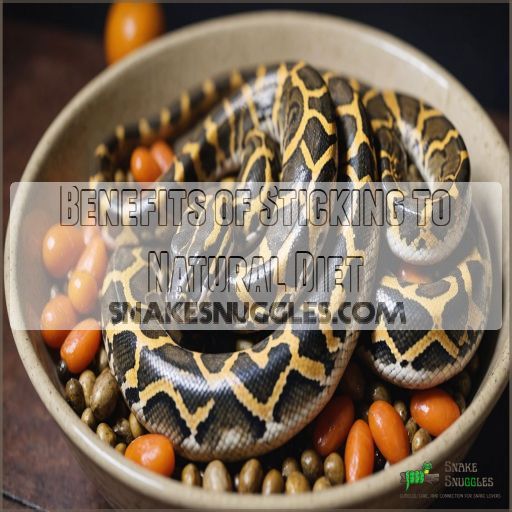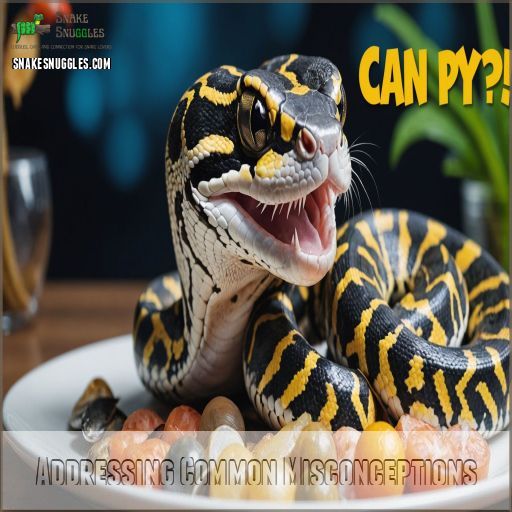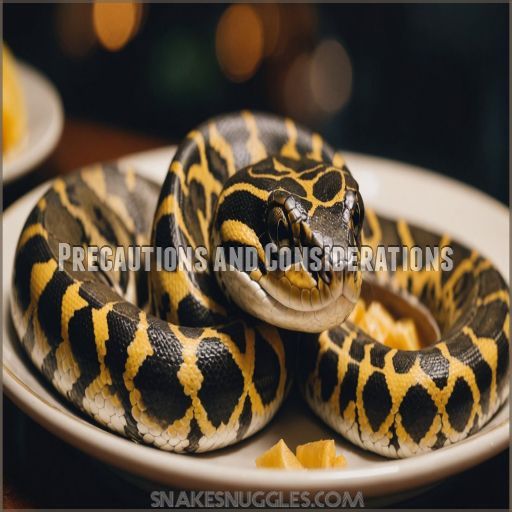This site is supported by our readers. We may earn a commission, at no cost to you, if you purchase through links.
 Sure, ball pythons can eat fish, but think of it as offering dessert rather than a main course.
Sure, ball pythons can eat fish, but think of it as offering dessert rather than a main course.
These reptiles naturally enjoy warm-blooded meals, like mice and rats, which match their evolutionary needs.
Feeding fish occasionally is okay, but too much can cause nutritional imbalances.
Some fish contain thiaminase, an enzyme that can lead to Vitamin B1 deficiency—bad news for your snake!
If you opt for fish, go for guppies or platies, but keep an eye on your python’s health.
Consider this a rare treat, not a daily meal.
Curious about the best care practices for your scaly friend?
Table Of Contents
- Key Takeaways
- Ball Pythons Natural Diet
- Risks of Feeding Fish to Ball Pythons
- Can Ball Pythons Eat Fish
- Safe Fish Options for Ball Pythons
- Feeding Fish to Ball Pythons Guidelines
- Preferred Foods for Ball Pythons
- Benefits of Sticking to Natural Diet
- Addressing Common Misconceptions
- Precautions and Considerations
- Frequently Asked Questions (FAQs)
- Can ball pythons eat fish?
- How do you get a ball python to eat?
- Should you feed your ball python only one type of prey?
- Can ball pythons go without food?
- Can I feed my python fish?
- What else can ball pythons eat?
- Can pet snakes eat fish?
- Can my ball python eat raw chicken?
- How often do ball pythons eat rodents?
- What nutrients do rodents provide ball pythons?
- Can fish oil supplements benefit ball pythons?
- How to transition diets for ball pythons?
- Are there any fish allergy signs in pythons?
- Conclusion
Key Takeaways
- You can give your ball python fish as a rare treat, but its main diet should be warm-blooded prey like rodents for optimal nutrition.
- Stick to safe fish options like guppies or platies, avoiding those with thiaminase like goldfish, to prevent vitamin B1 deficiency.
- Feeding fish too often can lead to nutritional imbalances, so monitor its health and keep fish as an occasional snack.
- Always consult a vet if you’re unsure about dietary changes to ensure your python stays healthy and happy.
Ball Pythons Natural Diet
You might think a ball python craves a nice fish dinner, but their natural diet mainly consists of small mammals like mice and rats.
These snakes can occasionally snack on birds or lizards, but they prefer their meals warm-blooded and furry, not finned and scaly!
Evolutionary Preference for Warm-Blooded Prey
Ball pythons naturally gravitate toward warm-blooded prey, which makes sense given their evolutionary history.
They use heat-sensitive pits to locate warm-blooded animals, ensuring energy efficiency and effective digestion.
Here’s why they prefer such prey:
- Energy Efficiency: Warm-blooded prey provides more calories.
- Digestive Adaptations: Easily digested with nutrients like vitamin B1.
- Prey Availability: Abundant in their natural habitat.
Small Mammals as Primary Food Source
With their sharp hunting instincts, ball pythons (python regius) naturally gravitate towards small mammals as their primary food source.
They use heat pits on their nose to detect the body temperature of their prey in wild environments.
Offering a variety of rodents provides top nutritional value and supports healthy growth.
While feeding frequency varies, selecting appropriately sized prey, from mice to larger rats, helps maintain their diet.
For any concerns, consult an exotic vet for personalized advice.
Occasional Consumption of Birds and Lizards
Though small mammals typically star on their menu, ball pythons occasionally munch on birds and lizards. These snacks add variety without needing a whole new cookbook!
- Birds as Prey: Wings make them tricky.
- Lizards as Prey: Easier to catch.
- Nutritional Value: Offers protein bursts.
- Frequency of Consumption: Rare but natural.
Keep their diet balanced, though!
Risks of Feeding Fish to Ball Pythons
Feeding fish to your ball python might seem like a fun change, but it can lead to nutritional imbalances and health risks.
Some fish have thiaminase, which can cause Vitamin B1 deficiency, so it’s important to be cautious.
Nutritional Imbalances and Deficiencies
Feeding your ball python a diet heavy in fish can lead to serious nutritional imbalances.
The thiaminase enzyme in many fish prevents vitamin B1 absorption, causing neurological issues like seizures (Source).
Calcium deficiencies and poor protein intake also impact your snake’s health.
Stick to rodents and birds for a balanced, natural diet.
| Nutrient Deficiency | Symptoms |
|---|---|
| Vitamin B1 | Neurological issues, seizures |
| Calcium | Metabolic bone disease |
| Protein | Stunted growth, poor gut health |
Potential Health Risks and Concerns
Fish might seem like an exotic treat for your ball python, but watch out for hidden dangers. These creatures face risks like parasite transmission and digestive upset, plus the infamous Salmonella risk. Fish can lead to nutritional imbalances due to their composition.
Keep your scaly friend safe with a rodent diet.
Here’s a quick rundown:
- Parasite transmission
- Digestive upset
- Salmonella risk
- Nutritional imbalances
- Potential disease transfer
Thiaminase and Vitamin B1 Deficiency
You might think fish is a handy treat for ball pythons, but watch out for thiaminase.
It’s an enzyme that breaks down thiamine, or vitamin B1, leading to deficiency.
Symptoms include muscle twitches and seizures.
Stick with fish types to avoid like goldfish and mackerel.
If symptoms arise, B1 supplements and a vet visit are essential.
Can Ball Pythons Eat Fish
Sure, ball pythons can eat fish, but it should be more of a rare treat than a regular meal.
While they aren’t picky eaters, sticking to safer fish like guppies or salmon can help prevent thiamine deficiency.
Fish as an Occasional Treat
Occasionally treating your ball python to fish can spice up their diet, like adding a new ingredient to a favorite recipe.
Make sure fish frequency is limited to avoid nutritional imbalances.
Since some pet snake breeds eat fish as part of their diets, such as Garter snakes and water snakes, it’s important to carefully consider their nutritional needs.
Consider these tips:
- Select low-thiaminase fish types to minimize fish risks.
- Prepare fish thoroughly to prevent health issues.
- Explore fish alternatives for well-rounded nutrition.
Safer Fish Options for Ball Pythons
When considering safer fish options for ball pythons, guppies and platies are fantastic choices, especially if sourced from a parasite-free environment.
Silversides, often available frozen, are a nutritious option because they don’t contain thiaminase.
Trout and tilapia, when used sparingly as treats, can add variety to your snake’s diet, promoting a healthy feeding routine.
Fish to Avoid Due to Thiaminase
Choosing fish for your ball python? Be careful! Thiaminase in fish can lead to Vitamin B1 deficiency, which is a risk you probably don’t want.
Some fish to avoid include:
- Goldfish, due to thiaminase dangers
- Common Carp, a thiaminase-rich fish
- Shad species, potential B1 troublemakers
- Black Bullhead Catfish, another name on the "fish to avoid" list.
Safe Fish Options for Ball Pythons
For feeding your ball python, you’ll want to stick to safer fish options like guppies, platies, and small trout.
Avoid wild-caught fish, as they may harbor parasites that could harm your slithery friend.
Guppies, Platies, and Small Trout
Ball pythons are obligate carnivores and thrive on a diet of whole prey, which can be safely sourced from a ball python diet food guide, but incorporating fish into a ball python’s diet raises concerns, especially regarding nutritional value and parasite risks.
However, guppies, platies, and small trout can be safer options.
These choices minimize thiaminase exposure, which affects vitamin B1 absorption.
Make sure you source them responsibly, checking for parasites.
Besides, remember to maintain the right feeding frequency and size considerations to keep your snake healthy.
Salmon and Smelt as Suitable Choices
Let’s face it—not all fish are created equal for ball pythons.
Luckily, salmon and smelt make the cut.
They’re nutritional powerhouses, lacking harmful thiaminase.
Just remember, moderation is key to avoid health issues.
Here’s a quick rundown:
- Nutritional value: High
- Thiaminase content: Absent
- Parasite risks: Low
- Feeding frequency: Occasional treat
Avoiding Wild-Caught Fish and Parasites
Avoiding wild-caught fish is important for your ball python’s health due to parasite risks.
Stick to captive-bred fish to guarantee fish safety.
Parasite prevention is a must for responsible feeding.
| Safe Fish Options | Risks | Alternatives |
|---|---|---|
| Trout | Parasites in wild fish | Captive-bred |
| Salmon | Nutritional imbalances | Pre-packaged |
| Smelt | Thiaminase presence | Freshwater species |
Feeding Fish to Ball Pythons Guidelines
When feeding fish to your ball python, you’ll want to stick to occasional treats, not daily meals.
Always heat the fish beforehand to encourage consumption and watch how your snake responds to adjust its diet if needed—because nobody likes a cold dinner or an upset stomach!
Control the portion size to match the width of the snake’s body.
Feeding Frequency and Portion Control
Moving from safe fish choices, let’s touch on feeding frequency and portion control.
Plan a fish feeding schedule once every few weeks, as too frequent meals can lead to nutritional imbalances.
Stick to small, appropriate portions to avoid overfeeding risks.
Think of fish as an occasional snack, not a banquet.
Remember, moderation is key for your python’s health!.
Heating Fish Before Feeding
Warming fish for your ball python isn’t just a creature comfort—it’s essential for digestion.
Aim for a fish temperature of around 80°F; cold fish could cause digestive issues.
Use safe heating methods, like warm water baths, and choose reliable heat source options, such as heat lamps.
Temperature control is key—too hot and you’re looking at fish jerky!
Monitoring Response to Fish
Once your ball python has eaten fish, monitor its response closely.
Pay attention to post-feeding behavior, appetite changes, and bowel movements.
If you notice regurgitation, lethargy, or other signs of illness, discontinue fish feeding.
Also, be aware of the parasite risk associated with feeding fish.
Preferred Foods for Ball Pythons
You should focus on a ball python feeding schedule learn ball python feeding frequency that includes feeding your ball python warm-blooded prey, like rodents and birds, to make sure they get the best nutrition.
Fish might seem like a convenient snack, but sticking with typical snake diets keeps your slithery pal happy and healthy.
Warm-Blooded Prey for Optimal Nutrition
When feeding your ball python, remember that warm-blooded prey best meets their nutritional needs.
This keeps them healthy and satisfied.
You might think fish is a fun alternative, but it doesn’t provide essential nutrients.
Feeding appropriate prey size is key, whether you opt for pre-killed or live.
Prioritizing a rodent-based diet promotes the best ball python health.
Rodents and Birds as Primary Food Sources
In the wild, ball pythons thrive on a steady diet of rodents and birds, offering ideal nutritional content.
They prefer prey like mice, rats, or weaver birds, given their easy prey availability and ideal rodent size.
Though their feeding frequency varies, these options keep them healthy.
Find these crunchy creatures irresistible? So do ball pythons!
Avoiding Fish as a Sole Food Source
Feeding ball pythons fish as their main diet isn’t wise.
Stick to rodents, which are packed with nutrients these snakes thrive on.
Fish, though an enticing novelty, could lead to a thiamine deficiency and disrupt nutritional balance.
- Stick to warm-blooded prey for the best health.
- Consider alternative prey sources, like birds.
- Ensure long-term health through a balanced diet.
Benefits of Sticking to Natural Diet
When you stick to a ball python’s natural diet, you help maintain their predictable and stable behavior while reducing the risk of health issues.
It’s like keeping a car tuned up with the right fuel so it runs smoothly, promoting healthy growth and development.
Predictable and Stable Behavior
Sticking to a natural diet helps your ball python’s predictable behavior, like clockwork!
It promotes stable feeding schedules and reduces common stress triggers.
You’ll love how well it adapts to regular handling and an ideal enclosure setup.
Here’s a quick reference:
| Aspect | Natural Diet | Fish Diet |
|---|---|---|
| Temperament | Predictable | Uncertain |
| Feeding Ease | High | Low |
| Stress Levels | Low | High |
Keep it simple for a happier snake!
Reduced Risk of Health Issues
You’ve made sure your ball python is stable, now focus on reducing health risks by sticking to a natural diet for your ball python. This path promotes:
- Nutritional balance, avoiding deficiencies linked to thiaminase found in fish.
- Parasite prevention, by steering away from wild prey.
- Safe feeding practices, sustaining your pet’s well-being with familiar, suitable meals like rodents.
Promoting Healthy Growth and Development
A natural diet promotes healthy growth and development in ball pythons by closely matching their wild nutrition, ensuring stability.
Feeding rodents provides the necessary proteins, fats, and calcium needs, reducing the reliance on vitamin supplements.
With a suitable diet variety, you’ll notice predictable behaviors and strong health.
Stick to tried-and-true husbandry practices, and watch them thrive! .
Addressing Common Misconceptions
You might think feeding your ball python fish is a great idea, but that’s a common misconception that deserves some debunking.
While fish can occasionally be offered as a treat, it shouldn’t replace their primary diet of warm-blooded prey.
Fish as a Suitable Alternative Food Source
While fish can offer nutritional value, they’re not the go-to snack for ball pythons.
Sure, a piece of salmon or trout might occasionally spice up the menu, but don’t make it the norm.
Ensuring proper digestion and growth is essential for a snake’s health, and fish types with thiaminase pose health risks, including vitamin B1 deficiency.
Stick with rodents for regular meals, ensuring your python’s safety and happiness.
Debunking The Myth of Fish as a Staple Food
Fish can seem like a fun treat for your ball python, especially if you’re looking to shake up their menu.
But don’t let that fool you into thinking it’s a staple.
These snakes naturally prefer a rodent-based diet.
Fish, containing thiaminase, can lead to Vitamin B1 deficiency, posing health risks, .
Stick with rodents for safety.
Precautions and Considerations
Before you add fish to your ball python’s menu, it’s important to consult a veterinarian or reptile expert to make sure they get a balanced and varied diet.
Keeping your scaly friend healthy means prioritizing its well-being with careful planning and expert advice—because nobody wants a fishy fiasco!
Consulting With a Veterinarian or Reptile Expert
Before introducing fish into your ball python’s diet, it’s wise to consult a veterinarian or reptile expert.
They can provide personalized guidance on safe feeding practices, ensuring your snake’s nutritional needs are met without risking health issues.
Their expertise can help you understand the challenges of ball python care and avoid potential pitfalls.
Ensuring a Balanced and Varied Diet
To keep your ball python’s diet well-rounded, focus on variety while considering factors like prey size and nutritional needs.
Mixing up meals is key, but don’t neglect supplements for added benefits.
To make sure a balanced diet, it’s important to consider ethical sourcing of prey and choose captive-bred animals.
Keep these points in mind:
- Rotate prey types for diet variety.
- Adjust prey size as your python grows.
- Use supplements for balanced nutrition.
- Monitor feeding frequency to prevent overfeeding.
Prioritizing The Health and Well-being of Ball Pythons
While balancing a varied diet is very important, always prioritize your ball python’s health and well-being.
Consult a reptile veterinarian for guidance and make sure you’re sticking to a proper feeding schedule.
Use parasite prevention for long-term care.
Your beloved python, after all, isn’t just an accessory; it’s a living, slithering bundle of scales that relies on your informed choices.
Frequently Asked Questions (FAQs)
Can ball pythons eat fish?
Isn’t it funny that a ball python might snack on fish?
Sure, they can eat fish, but it’s not their favorite.
Rodents should be their main meals.
Fish should be an occasional treat, chosen carefully.
How do you get a ball python to eat?
Start by checking your ball python’s habitat for suitable temperatures and humidity, which should include a substrate like reptile friendly coir. Start by checking your ball python’s habitat for suitable temperatures and humidity.
Feed at night, thaw frozen prey thoroughly, and consider offering live food only as a last resort.
Patience is key when dealing with picky eaters.
Should you feed your ball python only one type of prey?
Ah, the age-old dilemma – should you stick to one prey type for your slithery companion?
Well, my friend, it’s best to keep it simple.
Stick to mice or rats, and you’ll have a happy, healthy ball python on your hands.
Can ball pythons go without food?
Adult ball pythons can go 4-6 weeks without eating, sometimes even longer, especially during breeding season.
Juveniles, however, need food more often.
Keep an eye on weight and behavior to make sure they’re healthy and thriving.
Can I feed my python fish?
Feeding your python fish is possible but not ideal.
They mainly thrive on rodents, and fish should be an occasional treat.
Avoid species with thiaminase, like goldfish, to prevent vitamin B1 deficiency.
What else can ball pythons eat?
Ball pythons primarily eat rodents like mice and rats. While they generally thrive on this diet, some may occasionally refuse food, especially during breeding season or shedding cycles, as seen in Common Food Refusal in Ball Pythons.
They’ll also enjoy birds, shrews, or amphibians in the wild.
Just make sure the prey is the right size for your snake and easy to source.
Can pet snakes eat fish?
Some pet snakes like garter, water, and ribbon snakes relish fish in their diet.
However, many others don’t digest fish easily, so it’s essential to identify your snake’s species and dietary needs before trying.
Can my ball python eat raw chicken?
Did you know that over 90% of a ball python’s diet should be rodents, and you can safely learn how to defrost and warm frozen mice for them? over 90% of a ball python’s diet should be rodents?
While they can eat raw chicken occasionally, it’s not the healthiest option.
Stick to rodents for balanced nutrition and safer mealtime. (Source)
How often do ball pythons eat rodents?
You should feed your young ball python every 5-7 days.
For older pythons, aim for every 10-14 days.
As they mature, feed them once every 2-3 weeks.
It’s like setting up a cozy dinner routine.
What nutrients do rodents provide ball pythons?
Rodents provide ball pythons with a balanced diet, offering essential nutrients like protein, fat, and minerals. They’re the ideal prey, meeting your snake’s nutritional needs without requiring additional supplements. (Source)
Can fish oil supplements benefit ball pythons?
Omega 3 fish oil supplements can improve your ball python’s skin health, especially when you’re following the right feeding schedule for their age and size, reduce shedding issues, and support immune function.
Start with a small dose and consult a reptile vet for personalized guidance to make sure your pet’s safety.
How to transition diets for ball pythons?
To switch diets for ball pythons, gradually introduce new prey items like rats by scenting them with familiar smells, warming them, and experimenting with colors.
Patience is key, as they often resist change initially.
Are there any fish allergy signs in pythons?
Pythons don’t typically show fish allergy signs because they’re not naturally exposed to fish in their diet.
They mainly eat rodents and birds.
If you’re curious, consult a reptile vet for expert advice that fits your python’s needs.
Conclusion
Imagine your ball python eyeing a fish with curiosity—tempting, but it’s not the best primary meal.
Their natural diet, rich in rodents, supports their health and well-being.
When you ask, "Can ball pythons eat fish?" remember, it’s a rare treat, not a staple.
Carefully choose fish like guppies, avoiding those with thiaminase, and always prioritize your snake’s wellbeing.
Stick to their natural food for a happy, healthy snake, and consult experts when needed!

